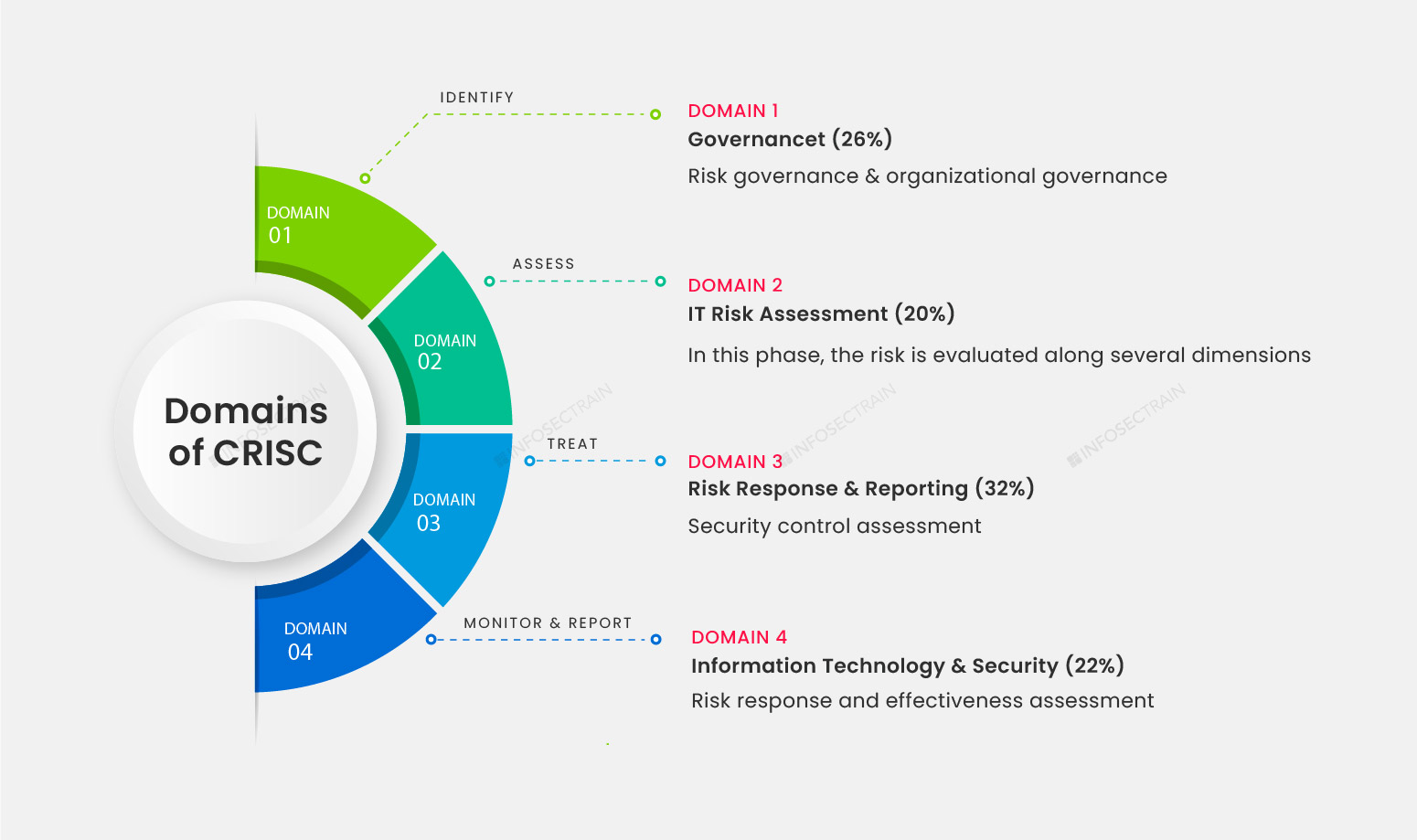Career Scope of CRISC

Table of Contents
What is the CRISC Certification?
CRISC Exam Domains
Benefits of CRISC Certification
Importance of CRISC
Career Opportunites after CRISC
What is the CRISC Certification?
CRISC is the most sought-after certification among individuals seeking to flourish IT risk management. ISACA Certified in Risk and Information Systems Control (CRISC) is a globally accepted and recognized certification. The CRISC professionals demonstrate Enterprises Risk Management (ERM) and Information System (IS) control skills. CRISC addresses the need for professionals who understand both technology and implement and align effective risk management and control frameworks with enterprise goals. A CRISC is generally responsible for developing, implementing, and maintaining Information System (IS) controls designed to protect systems and manage risk.
CRISC Exam Domains
The CRISC certification exam is divided into four domains, each with a different weightage. When you are ready to pursue a career in risk management, the best method to prepare for this exam is to become familiar with all four domains. You can check it here:
Domain1: Governance
Domain 2: IT Risk Assessment
Domain 3: Risk Response and Reporting
Domain 4: Information Technlogy and Security

Benefits of CRISC Certification
CRISC certification provides a number of benefits in addition to addressing the complex organizational structures and information breakdowns inside an organization.
- Career growth: The CRISC certification is the only certification that focuses on enterprise IT risk management, leading to various job opportunities. CRISC certifies your experience in developing a well-defined, agile risk-management program based on best practices for risk identification, analysis, evaluation, assessment, prioritization, and response.
- Improved operational efficiency: Due to constant ongoing supervision of controls and risk exposure, establishing a risk management framework eventually automates standard methods. This results in more effective ways of conducting tasks and assists in the reduction of unnecessary measures within your organization.
- Improved quality information: A management team could be better positioned to make more informed and productive decisions using integrated governance, risk, and compliance approach.
- Reduced Costs: Implementing effective risk management activities aids in the development of business rules, control analysis, and incorporation, as well as developing an IT risk management strategy that allows enterprises to save money.
- Acquire a high-paying job: Risk management professionals are high in demand as they are the specialist in any organization to evaluate risk assessment. The CRISC credential demonstrates to employers that you are committed to the field and well-qualified for the position, potentially allowing you to earn a higher salary.
Importance of CRISC
As we can see in our daily lives, cybercrime, particularly data theft and fraud, is on the rise. And here, IT risk management comes into the scenario due to the growing number of cyberattacks. The purpose of IT risk management is to ensure that appropriate rules and controls are in place to reduce risk, provide a system of checks and balances to inform professionals when new risks emerge and improve the efficiency and effectiveness of organizational processes.
CRISC-certified professionals have a better knowledge of information technology risks. They develop plans and strategies to mitigate and manage those risks, that affect an entire organization:
- It indicates a renowned, lifetime representation of knowledge and skill as a risk professional.
- Increases your worth to any organization seeking to manage IT risk efficiently.
- It gives you a competitive edge over your competitors regarding your job growth.
- It helps you reach a high professional standard by adhering to ISACA’s continuous education and ethical conduct guidelines.
Career Opportunites after CRISC
CRISC is the only credential that specializes in enterprise IT risk management. CRISC acknowledges your efforts in developing a very well, a flexible risk-management program based on best practices for identifying, assessing, evaluating, analyzing, classifying, and responding to risks. This improves the realization of benefits and provides the best value to the organization. The following are some jobs that will benefit the most from CRISC:

- Cybersecurity Analyst: A Cybersecurity Analyst is a skilled cyber expert who focuses on network and IT infrastructure security. The Cybersecurity Analyst is well-versed in cyberattacks, viruses, and malicious cyber activity and actively detects and avoids these attacks. In the United States, the average annual salary for a Cyber Security Analyst is $99,815 year.
- IT Security Analyst: An IT Security Analyst keeps track of security measures and guards against illegal access to computers, devices, networks, and data. The average IT Security Analyst’s salary is $52,625, ranging from $45,726 to $55,617.
- Information Security Analyst: Information Security Analysts protect their organization’s data by designing and implementing cyberattack prevention and mitigation techniques. The average salary of an Information Security Analyst in the United States was $82,270, with a salary range of $73,731 to $92,037.
- Risk Analyst: A Risk Analyst evaluates and analyzes risks to help clients make informed investment decisions. Support customers in meeting the organization’s financial objectives, and a Risk Analyst can devise a strategy for reducing risks. As of January 27, 2022, the average Risk Analyst salary in the United States is $60,759; however, the range frequently lies between $52,730 and $71,132.
- Technology Risk Analyst: The Information Risk Analyst directs threat, risk, and data science activities to safeguard the organization and its clients from information and cyber security threats. According to Glassdoor, the average total salary for a Technology Risk Analyst is $89,658 per year in the United States.
- Risk Manager: The Risk Manager is in charge of identifying the types of risks that could affect a company’s financial performance, legal compliance, or reputation. Communication with firm leadership, department managers, or legal staff is one of their responsibilities. According to Glassdoor, the average salary of a Risk Manager is $107,560 per year in the US.
According to ZipRecruiter, the average CRISC salary in the United States is $1,32,266. According to Payscale, the average yearly compensation in CRISC is $20,00,000.
CRISC with InfosecTrain
CRISC holders assist organizations in assessing business risks and possess the technical expertise required to establish appropriate IS controls. CRISC training course from InfosecTrain prepare IT professionals to deal with enterprise risk management issues. Enroll in our CRISC certification training course to reap the benefits of being trained by industry professionals.




 1800-843-7890 (India)
1800-843-7890 (India) 
